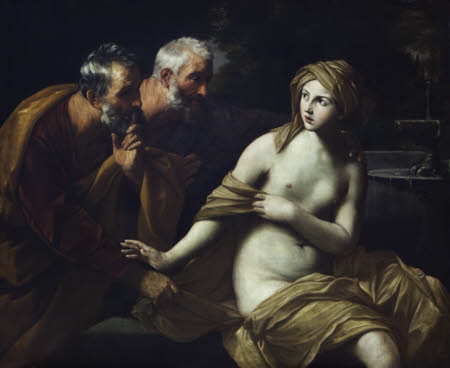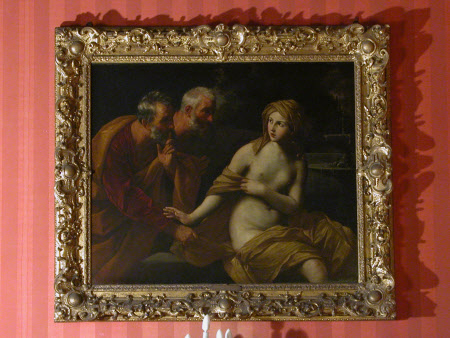Susannah and the Elders
after Guido Reni (Bologna 1575 – Bologna 1642)
Category
Art / Oil paintings
Date
1600 - 1699
Materials
Oil on canvas
Measurements
1295 x 1588 mm (51 x 62 1/2 in)
Place of origin
Italy
Order this imageCollection
Shugborough Estate, Staffordshire
NT 1271039
Caption
The biblical episode depicted is from the apocryphal book of Susannah (15-24) in the Old Testament or the book of Daniel (13) depending on a Jewish (Hebrew) and Protestant or Roman Catholic (Vulgate) and Eastern Orthodox point of view respectively.It shows the attempt of two elders of the Synagogue to seduce the virtuous Hebrew wife, Susannah, whilst she was bathing in a secluded spot with no witnesses. They attempt to seduce her and when she refuses, to blackmail her. She is arrested and about to be put to death for promiscuity when Daniel comes to the rescue with an irrefutable challenge over the size and type of tree she allegedly met her lover. The story was popular with artists from the Renaissance onwards giving them the opportunity of showing the female nude body, piquantly contrasted with the physiognomies of old age. There are many known versions from the workshop of Reni and the supposed original of this version, of around 1620-23, was from the Palazzo Lancelloti, Rome. By 1787 it had been hung as a pendant to the artist's earlier Lot and his Daughters leaving Sodom. Both were bought by the National Gallery in 1844.
Summary
Oil painting on canvas, Susannah and the Elder, after Guido Reni (Bologna 1575 – Bologna 1642), 17th century. An almost-naked female, wearing a turban, three-quarter length, sits on the right by fountain on the far right, and turning to her right, facing two elderly men, approaching her from the left, one with hand raised to his lips. As the virtuous and beautiful Susannah bathes in her garden, she is approached by two elders who, lusting after her, threaten to accuse her of adultery if she does not sleep with them. She refuses and is falsely accused by them, but her innocence is proved and prevents her from being stoned.
Provenance
Presumably, like NT 1271037, bought by Thomas Anson MP (1695-1773) between 1765 and 1771, possibly from Sir John Dick, Bt (1719 -1804), Consul at Leghorn (Livorno); because of gambling debts of Thomas, 2nd Viscount Anson (1795-1854) in Shugborough sale, 1842, lot 111, bought (possibly by Madarin) for Lord Lichfield ie. Thomas William Anson, 1st Earl of Lichfield, PC, MP (1795 – 1854); transferred to the National Trust with Shugborough’s park and contents of the state rooms, in part-payment of death-duties to the Treasury, following the death of Thomas, 4th Earl of Lichfield (1883 - 1960)
Credit line
Shugborough, The Anson Collection (National Trust)
Makers and roles
after Guido Reni (Bologna 1575 – Bologna 1642), artist
References
Pepper 1984 D. Stephen Pepper, Guido Reni: A Complete Catalogue of his Works with an Introductory Text, Oxford 1984, p. 241,no. 72, copy 6.

